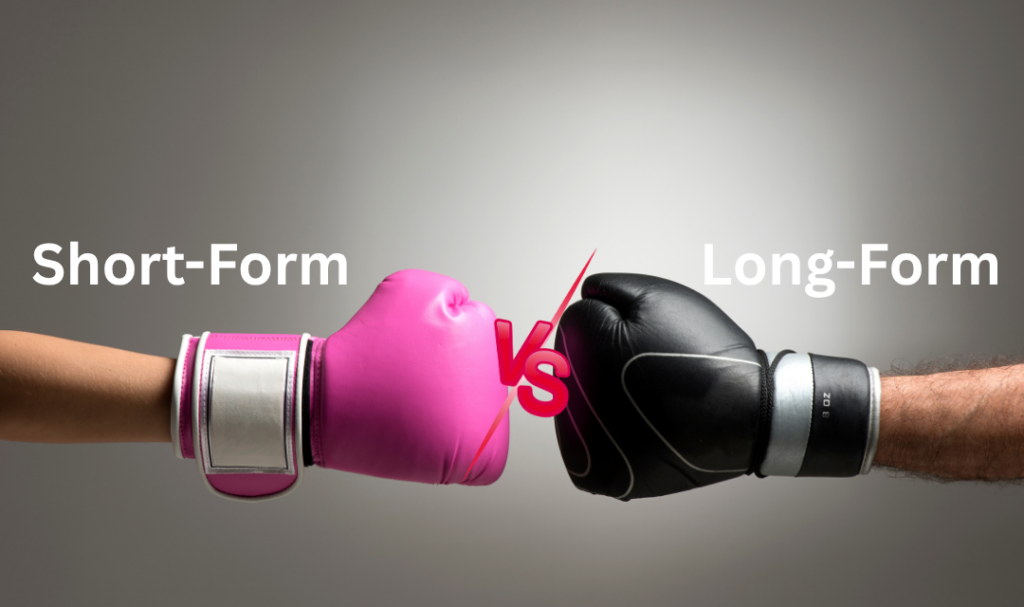
Let’s be honest—video content isn’t just a trend anymore. It’s the way people are consuming information, entertainment, and everything in between. Whether you’re doom-scrolling TikTok or settling in for a YouTube deep dive, it’s clear that video is dominating our screens—and if you’re in content creation or marketing, it needs to dominate your strategy too.
But here’s the thing: not all video is created equal. While a snappy 15-second clip might earn you likes and shares, it might not be the best choice if you’re trying to build trust or explain something in depth. That’s where knowing the difference between short-form and long-form video—and how to use each—is key.
The Dominance of Video Content in Social Media

Let’s face it—video has taken over our feeds. Whether you’re on TikTok, Instagram, YouTube, or even LinkedIn, videos are everywhere. And it’s not just about entertainment anymore—video is how people learn, shop, discover new brands, and connect with creators.
Why? Because video feels more personal. It grabs attention faster than text or images, and when done well, it makes people feel like they know you—even if it’s just a 15-second clip. Social media algorithms know this too, which is why video content often gets boosted, recommended, and shared more than any other format. If you’re not using video yet, you’re likely missing out on a huge chunk of your potential audience.
Need proof? Just take a look at how Digivox Global has helped grow client social media accounts using proven video-first strategies and real performance data.
So, the question isn’t should you use video. It’s how you should use it—and which type makes sense for your message.
Differences Between Short-Form and Long-Form Videos

Let’s break it down simply:
- Short-form videos: are typically under 60 seconds. Think TikToks, Instagram Reels, YouTube Shorts. They’re quick, punchy, and designed for short attention spans (which, let’s face it, we all have sometimes).
- Long-form videos: run longer—anything from a few minutes to over an hour. These are your YouTube explainers, webinars, interviews, or storytelling vlogs.
Short-form is about quick connection, while long-form is about deep engagement. Both serve different purposes, and both are valuable in their own way.
Platforms Best Suited For Each Format
It’s not just about length—it’s about platform and purpose.
Short-Form Video Works Best On:
- TikTok
- Instagram Reels
- YouTube Shorts
- Facebook Stories
- LinkedIn (for quick updates or promos)
These platforms are designed for scroll-friendly, algorithm-driven content. They reward creativity, fast hooks, and high engagement.
Long-Form Video Thrives On:
- YouTube
- Facebook Watch
- IGTV (less popular, but still used)
- Your own website (especially for educational or evergreen content)
- Webinars and live streams (Zoom, LinkedIn Live, etc.)
Long-form is where your brand can build real authority and trust. It’s great for product demos, in-depth interviews, tutorials, or personal storytelling.
Tips for Creating Compelling Video Content (No Matter the Length)

Start strong
Hook your viewer in the first 3–5 seconds. Ask a question, show something unexpected, or tease what’s coming next.
Stay on message
Don’t try to cram too much into one video. Whether it’s 15 seconds or 15 minutes, keep your focus clear.
Design for silent viewing
Use captions. Seriously. Most people scroll with sound off, especially on mobile.
Keep it authentic
You don’t need a massive budget. Sometimes a slightly messy, real moment performs better than a polished production. People relate to people—not perfect robots.
Plan your CTA
Always give your audience a next step—such as commenting, following, sharing, visiting a link, or continuing to watch.
Looking to take your video content to the next level? Digivox Global can help you plan, create, and promote videos that actually get seen—and convert.
Measuring Engagement & Effectiveness
Here’s where it gets fun (or nerve-wracking, depending on your metrics obsession 😅).
For short-form:
- View count and watch time are key
- Shares and saves show real interest
- Comments give insight into viewer reaction
- Follower growth is a solid indicator of overall momentum
For long-form:
- Average watch duration tells you if people are actually staying
- Click-throughs (to your website or offer) measure conversion power
- Subscriber growth shows long-term interest
- Comments and likes gauge emotional connection
Tip: don’t just focus on vanity metrics. A million views mean nothing if nobody’s clicking, buying, or engaging with your brand afterward.
Can Short-Form Videos Lead to Long-Term Engagement?

Short-form videos might feel like just quick attention-grabbers, but when they’re part of a bigger strategy, they can absolutely lead to deeper audience connections. That 15-second tip or funny moment can be the spark that makes someone stick around to learn more.
The key is what comes next. If your short content is consistent with your message and brand, and if you offer more value beyond the scroll, viewers are more likely to follow, engage, and come back for more. Think of it as the invitation—not the full conversation.
So don’t treat short-form like a throwaway. Use it to tease longer videos, link to a deeper story, or simply give people a reason to explore your content further. It’s a powerful gateway when you use it with purpose.
What Types of Stories Work Best in Long-Form Video?
Long-form video is your space to go deep, and some stories shine best when they have room to breathe. Personal journeys, lessons learned, or real behind-the-scenes moments connect especially well here because they feel authentic and relatable.
Educational content is another great fit—tutorials, demos, or step-by-step breakdowns give people real value. When someone spends 10 or 20 minutes with your content and walks away with something useful, that builds serious trust.
And if you’ve got a process or mission worth showing off, let people in on it. The more transparent and detailed your story, the more likely people are to invest—not just in your video, but in you.
How Do You Know If Your Audience Prefers Short or Long Video?

If you’re not sure which format your audience likes more, the answer is simple: try both. Mix things up and see what performs best—do people comment more on your quick reels, or are they sticking around to watch your longer videos?
You don’t have to guess. Use polls in your Stories, ask questions in your captions, or check your analytics to see where people drop off or engage most. Your audience will tell you what they prefer—you just have to be listening.
And remember, preferences aren’t fixed. People might love a short burst of content one day and dive into a 10-minute deep dive the next. Giving them options helps you stay flexible and relevant.
FAQs About Trending Reels and Video Content
What kind of reels go viral right now?
Trends come and go fast, but quick tutorials, relatable humor, before-and-after transitions, and “aesthetic routine” videos are hot. Jumping on sound trends early can give you a boost, too.
Do I have to follow every trend to get views?
Not at all. Trends help with visibility, but original content that solves a problem, tells a story, or feels real often performs even better—especially over time.
Can long-form content still perform well on social platforms?
Yes. Platforms like YouTube prioritize watch time, and even Instagram is starting to reward longer videos via carousels and IGTV archives. As long as the content is engaging, long-form absolutely has a place.
Should I use trending audio on all my short-form videos?
Trending audio can definitely boost your reach, especially on TikTok and Instagram Reels. However, make sure the audio actually fits your content and brand. It’s better to use relevant audio that serves your message than to force trending audio that doesn’t make sense.
Is it okay to repurpose content from long-form to short-form?
Definitely. In fact, it’s smart. Pull short clips or key moments from long-form videos and repurpose them as Reels, Shorts, or Stories. This stretches your content and expands your reach.
How often should I post video content?
Consistency matters more than frequency. It’s better to post one high-quality video per week consistently than to post daily for a few weeks and then disappear. That said, platforms like TikTok and Instagram tend to reward frequent posting, so if you can maintain quality while posting 3-5 times per week, that’s often ideal.
How important are hashtags for video content?
Hashtags are still important, but they’re not magic bullets. Use relevant hashtags that your target audience might search for, but don’t sacrifice caption space for hashtag stuffing. 5-10 strategic hashtags usually work better than 30 generic ones.
Is it worth investing in video ads?
If you’re seeing good organic engagement with your video content, paid promotion can amplify your reach effectively. Start small, test different targeting options, and focus on promoting your best-performing organic content first.
Conclusion: Balancing Video Content Types for Maximum Impact
Here’s the bottom line—you don’t have to choose between short-form and long-form. In fact, the best video strategies blend both.
Use short-form to grab attention. Use long-form to build trust and depth. Think of short clips as the trailer, and long-form as the full movie.
By meeting your audience where they are—on the platforms they prefer, in the format they like best—you’re not just chasing views. You’re creating real, meaningful engagement.
If you’re only using one format, you’re leaving opportunity on the table. Video content isn’t just about trends—it’s about connection. Use it well, and your audience will not only watch—they’ll stick around. And that’s what makes a video strategy actually work. That’s how you stay relevant and build real loyalty.


One Response